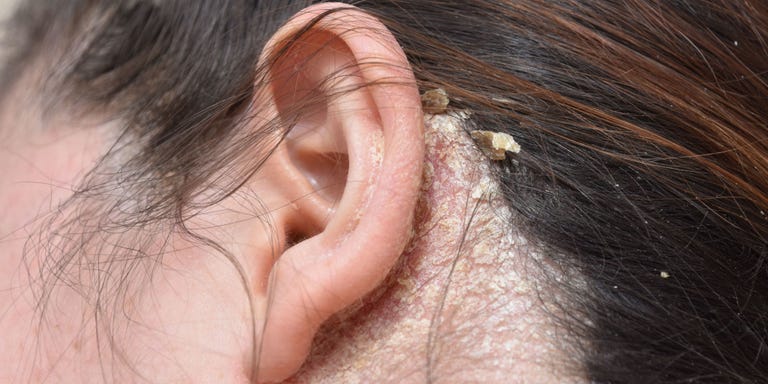
GETTY IMAGES
The term "eczema" comes from a Greek word meaning "to boil over," and the etymology is pretty spot-on. This group of conditions involving red, itchy, and inflamed skin can become both uncomfortable and embarrassing, but they're also manageable most of the time.
The flare-ups may appear similar at first glance, but dermatologists actually treat six different kinds of eczema: atopic dermatitis, contact dermatitis, dyshidrotic eczema, nummular eczema, seborrheic dermatitis, and stasis dermatitis.
No matter which type you have, all patients should practice gentle skin care, advises dermatologist Tina Bhutani of the University of California, San Francisco Medical Center. That involves moisturizing regularly and taking short, lukewarm (not hot) showers. If your fingers prune up, you're likely in there too long.
Use plain, fragrance-free soap like Cetaphil Gentle Cleanser or Dove Sensitive Skin Beauty Bar only on the visibly dirty areas of your body and folds like your armpits and groin. "Your skin makes natural soaps," Dr. Bhutani explains. "When we use external soap, we're overdoing it."
Then apply lotion all over from a tub — not a pump (it's thicker!) — no more than three minutes after you get out of the shower. You won't experience that squeaky clean feeling you might be used to, but that sensation is actually a sign you've dried out your skin too much, she says.
While these practices will help keep your skin hydrated and happy, eczema often requires some additional TLC. Read up on the six different types below, and what a derm might recommend to get your skin clear and glowing once again.
1Atopic Dermatitis: Persistent Red Patches
The most common form of eczema is also a chronic one. "Sometimes it's worse, sometimes it's better, but it's always there," Dr. Bhutani says. It usually starts in childhood, but adults can develop it too. Patients notice scaly patches, redness, inflammation, swollen skin, and sometimes open wounds, oozing, or crusting caused by scratching. Commonly affected areas include the elbows, knees, hands, feet, eyelids, and nipples.
Dermatologists suspect the condition stems from an overactive immune system combined with a difference in one's skin cells. "The skin is much more dry and also everything in the environment such as allergens and irritants can get in more easily," Dr. Bhutani explains.
The treatment: Depending on the severity, a derm might prescribe a topical, oral, or injectable prescription. UVB light therapy in a doctor's office a few times a week can also help.
2Seborrheic Dermatitis: Dandruff
It isn't usually thought of as eczema, but scalp dandruff falls in this category. Besides your head, you might also find the greasy plaques and flakes on the eyebrows, nose, chest, or back. Doctors believe that in these cases, a yeast that normally appears in the skin overgrows in gland-produced oils, causing the immune system to react.
The treatment: A doctor would probably recommend an anti-yeast shampoo, like OTC options Head and Shoulders and Selsun Blue, or a prescription version.
3Contact Dermatitis: Itchy Redness
There are two types of contact dermatitis: irritant and allergic. Irritant is the redness that occurs on the skin's outermost layer after something like, say, wearing a bandage. In allergic contact dermatitis, the rash manifests as an immune response. One common example is poison ivy.
The treatment: Your derm will identify the cause — whether it's an allergy to a dye in makeup, a preservative in wet wipes, or even the nickel in the button of your jeans. Since only the exposed areas are the ones affected, a doc can use the location to determine what's causing it and go from there, prescribing an oral or topical steroid if necessary.
4Stasis Dermatitis: Rash on Swollen Areas
This one usually happens in the elderly on the lower legs, Dr. Bhutani says. As your circulation diminishes with time, you get fluid build-up. The immune system then tries to correct the swelling, but an over-response may also cause a crusty rash on top of the inflamed areas. (Note: This condition can look a little icky, but if you want to see a photo)
The treatment: Derms can prescribe creams, but they'll also want to treat the underlying problem. Elevating the legs more frequently and wearing compression socks can also help with poor circulation.
5Dyshidrotic Eczema: Red Bumps on the Hands and Feet
Along with statis, this type is less common. It usually crops up in the winter time on the hands and feet. You might develop red patches and pimple- or blister-like bumps on your fingers and toes.
The treatment: Doctors will probably advise moisturizing regularly — especially if you experience flare-ups in dry weather — as well as using special topical creams.
6Nummular Eczema: Circular Patches
Nummular means "coin-shaped" in Latin, so it makes sense that this type manifests as circular patches. The reaction usually occurs on the legs during the wintertime and it's more commonly seen in the elderly, but nummular eczema can affect anyone, Dr. Bhuntai says.
The treatment: A topical cream can also help with this seasonal condition.












No comments:
Post a Comment